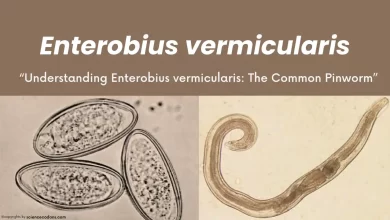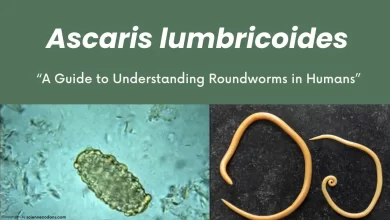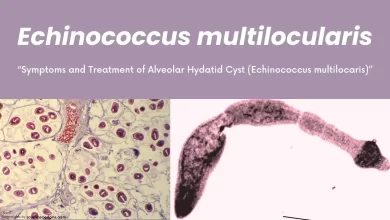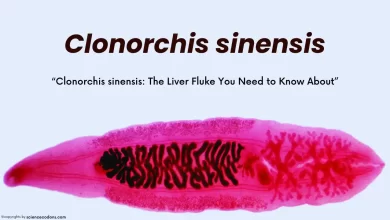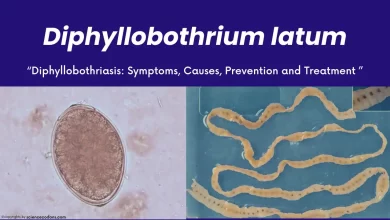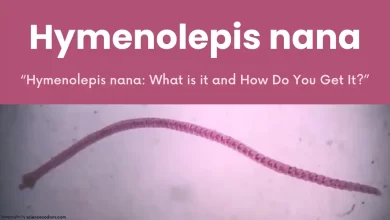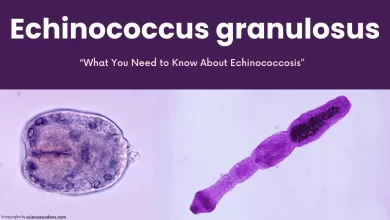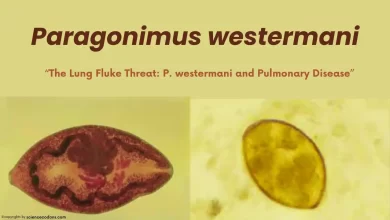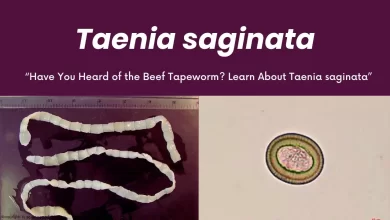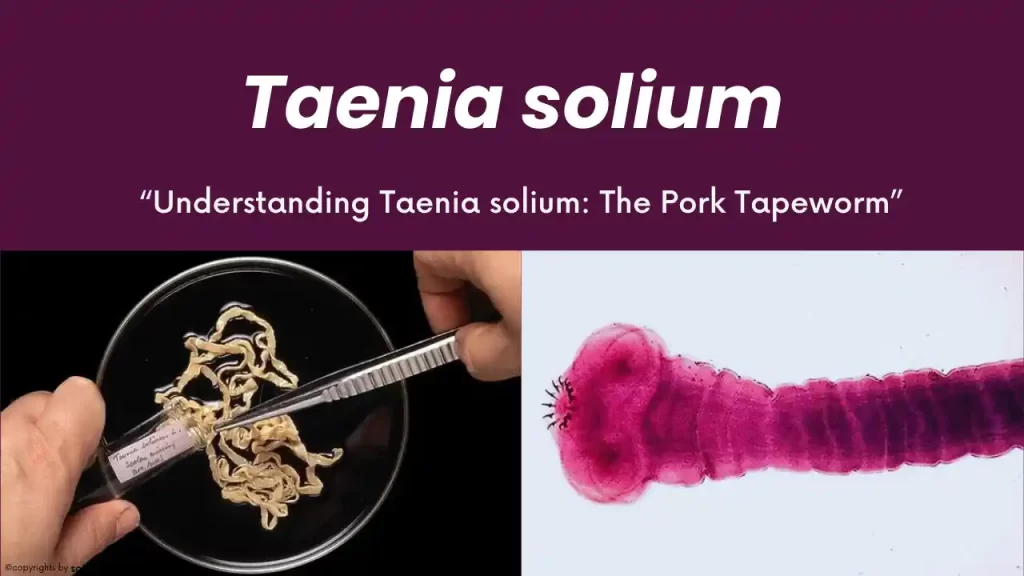
Taenia solium, also known as the pork tapeworm, is a member of the Cestoda class of tapeworms. It belongs to the Cyclophyllidea order and the Taeniidae family. The worm gets its name from its sun-like appearance when viewed from above the scolex (head), where the hooks are radially arranged (sol=sun).
What is Taenia solium? [Morphology & Characteristics]
The morphology of Taenia solium is characterized by its white, milky color and a length of about 2-4 meters. It has fewer segments (about 800-1000) than Taenia saginata. The scolex is spherical and has 4 suckers, a rostellum, and two rows of hooks, making T. solium an armed pumpkin worm. The fertile segments of this worm resemble pumpkin seeds. Taenia solium has a maximum lifespan of about 25 years.
The life cycle and transmission of T. solium
The life cycle of T. solium begins in the human intestine, where the adult worms reside. The human host excretes fertile segments containing eggs with feces. These eggs end up in water and sewage. If a pig, which serves as the intermediate host, consumes a plant contaminated with these eggs, it becomes infected. Within 2-3 months, the larval stage called Cysticercus cellulosae forms in the pig’s muscles. If a human consumes raw or half-cooked pork, the worm matures in the intestine within 3 months and begins to excrete segments.
| Stage | Description |
|---|---|
| 1 | Humans ingest undercooked pork containing cysticerci (larvae). |
| 2 | Cysts attach to the small intestine and mature into adult worms. |
| 3 | Adult tapeworms produce proglottids, which become gravid and detach. |
| 4 | Gravid proglottids or eggs are passed in feces. |
| 5 | Pigs or humans ingest eggs or proglottids, becoming intermediate hosts. |
| 6 | Oncospheres hatch, penetrate the intestinal wall, and enter the bloodstream. |
| 7 | Oncospheres develop into cysticerci in muscles or organs, leading to cysticercosis. |
Humans can also serve as an intermediate host for Taenia solium. The eggs hatch in the intestine, and the larva migrates through the bloodstream to various parts of the body, including the brain and eyes, forming the larval stage of Cysticercus cellulosae in the human body.
Infection with the larval stage of T. solium can lead to a condition called cysticercosis in humans. This condition can cause severe contamination in the brain and can even be fatal, making this worm more dangerous than Taenia saginata.
How does Taenia solium affect humans?
Autoinfection occurs internally and externally in Taenia solium as follows:
- If the egg opens in the intestine due to constipation and the larva comes out and is transferred to the brain, eyes, subcutaneous tissues, and muscles through the blood, internal autoinfection has occurred.
- If the segments decay and are excreted with feces and the person does not wash their hands completely after defecation, these eggs remain under the nails, and later, when they eat food, they enter the digestive system. In this case, external autoinfection occurs.
Taenia solium symptoms
The gastrointestinal symptoms caused by T. solium are similar to those caused by Taenia saginata but to a lesser extent. The greatest danger associated with this is related to cysticercosis, which can occur in humans in the larval and adult stages. Depending on where the cyst forms, it can cause a variety of symptoms, including convulsions, neurological-psychiatric symptoms such as epilepsy, increased intracranial pressure, migraine headaches, muscle pain, and blurred vision (if in the eye).
| Symptoms | Description |
|---|---|
| Pain | Abdominal pain may occur. |
| Unexplained Weight Loss | Some individuals experience weight loss without an obvious cause. |
| Blockage of the Intestine | The tapeworm can cause intestinal blockage. |
| Digestive Problems | Digestive issues such as nausea, diarrhea, and upset stomach may arise. |
| Irritation in the Perianal Area | Worm segments or eggs being expelled in the stool can cause irritation around the anus. |
Diagnosis of Taenia solium
The diagnosis of an infection with T. solium is typically made through a stool test. This involves examining the presence of eggs or fertile segments in the stool, a method used for adult worms. By counting the branches, we can distinguish them from Taenia saginata.
For diagnosing Cysticercus, the larval stage of the worm, we use imaging techniques like brain CT scans and MRIs, serological techniques like ELISA and IFA that search for antibodies in the patient’s serum, and molecular techniques like PCR to examine cerebrospinal fluid (CSF). Usually, the patient’s protein and white blood cell count are high, and mild eosinophilia is seen in the blood test.
Eosinophils are granular white blood cells that increase in helminthic infections. An increase in eosinophils in the blood is referred to as eosinophilia.
Prevention and Treatment of Taenia solium
As with other helminthic infections, the primary way to combat Taenia solium is to prevent infection. This involves disrupting the life cycle of the worm to prevent its spread and further infections. Recommended methods for this include:
- Sanitary disposal of human sewage
- Proper and thorough cooking of pork
- Storing meat in the freezer at a temperature of minus 20 degrees Celsius
- Treatment of patients infected with Taenia solium
- Regular handwashing and maintaining personal hygiene to avoid fecal-oral transmission.
By understanding the lifecycle and risks associated with T. solium, we can take steps to prevent its spread and safeguard public health.
How do you get rid of T. solium?
For the treatment of infection with Taenia solium, it is recommended to use albendazole or praziquantel.
- Albendazole is used for 8-28 days at a dose of 15 milligrams per kilogram of body weight.
- Praziquantel is used three times a day for 15 days at a dose of 50 milligrams per kilogram of body weight.
Steroids like Dexamethasone are also used to reduce inflammation caused by larvae. In more severe cases, surgery can be used to remove the larvae.
It’s important to note that treatment should always be under the supervision of a doctor and with a complete examination of your condition, as self-medication can lead to drug resistance, side effects, shock, and even death.
Conclusion
Taenia solium represents a significant health concern, particularly in regions where pork consumption is common, and sanitation practices are inadequate. Understanding its lifecycle is crucial for preventing both taeniasis and cysticercosis. Proper cooking methods, sanitation, and hygiene can greatly reduce the incidence of infections. Continued public health education and improved food safety standards are essential in combating the spread of this parasite and protecting communities worldwide. Remember, prevention is key to controlling infection. If you need more in-depth information or specific details, feel free to ask!
Reference
- WHO
- Bobic, Branko & Ćirković, Vladimir & Klun, Ivana & Štajner, Tijana & Srbljanović, Jelena & Bauman, Neda & Djurkovic Djakovic, Olgica. (2021). Epidemiology of Taenia solium infection in the Russian Federation in the last 20 years: a systematic review. Journal of Helminthology. 95. 10.1017/S0022149X21000432.
- García, Héctor H et al. “Taenia solium cysticercosis.” Lancet (London, England) vol. 362,9383 (2003): 547-56. doi:10.1016/S0140-6736(03)14117-7
- https://www.nejm.org/doi/full/10.1056/NEJMoa1515520
- https://doi.org/10.1016/S0001-706X(03)00055-X
